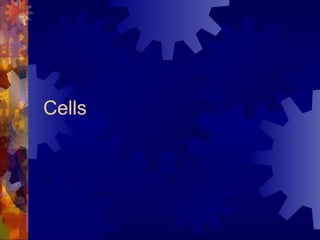7.1 cell discovery and theory
•Download as PPT, PDF•
1 like•1,950 views
The microscope enabled the discovery of cells. In 1665, Hooke observed box-shaped structures in cork which he called "cells". Van Leeuwenhoek later saw living organisms in pond water and milk using an improved microscope. In the 1830s, scientists established that plants and animals are composed of cells, and that cells only arise from pre-existing cells (Cell Theory). Modern compound and electron microscopes allow detailed study of prokaryotic and eukaryotic cell structures and organelles.
Report
Share
Report
Share

More Related Content
What's hot
What's hot (20)
Introduction and importance of biological evolution

Introduction and importance of biological evolution
Viewers also liked
Viewers also liked (6)
Similar to 7.1 cell discovery and theory
Similar to 7.1 cell discovery and theory (20)
More from kathy_lambert
More from kathy_lambert (20)
6.4 organic compounds notes(teacher)for slideshare

6.4 organic compounds notes(teacher)for slideshare
Recently uploaded
Mattingly "AI & Prompt Design: The Basics of Prompt Design"

Mattingly "AI & Prompt Design: The Basics of Prompt Design"National Information Standards Organization (NISO)
Mattingly "AI & Prompt Design: Structured Data, Assistants, & RAG"

Mattingly "AI & Prompt Design: Structured Data, Assistants, & RAG"National Information Standards Organization (NISO)
Recently uploaded (20)
18-04-UA_REPORT_MEDIALITERAСY_INDEX-DM_23-1-final-eng.pdf

18-04-UA_REPORT_MEDIALITERAСY_INDEX-DM_23-1-final-eng.pdf
Interactive Powerpoint_How to Master effective communication

Interactive Powerpoint_How to Master effective communication
Beyond the EU: DORA and NIS 2 Directive's Global Impact

Beyond the EU: DORA and NIS 2 Directive's Global Impact
Introduction to ArtificiaI Intelligence in Higher Education

Introduction to ArtificiaI Intelligence in Higher Education
Privatization and Disinvestment - Meaning, Objectives, Advantages and Disadva...

Privatization and Disinvestment - Meaning, Objectives, Advantages and Disadva...
TataKelola dan KamSiber Kecerdasan Buatan v022.pdf

TataKelola dan KamSiber Kecerdasan Buatan v022.pdf
Call Girls in Dwarka Mor Delhi Contact Us 9654467111

Call Girls in Dwarka Mor Delhi Contact Us 9654467111
Mattingly "AI & Prompt Design: The Basics of Prompt Design"

Mattingly "AI & Prompt Design: The Basics of Prompt Design"
Z Score,T Score, Percential Rank and Box Plot Graph

Z Score,T Score, Percential Rank and Box Plot Graph
Mattingly "AI & Prompt Design: Structured Data, Assistants, & RAG"

Mattingly "AI & Prompt Design: Structured Data, Assistants, & RAG"
Hybridoma Technology ( Production , Purification , and Application ) 

Hybridoma Technology ( Production , Purification , and Application )
7.1 cell discovery and theory
- 1. Cells
- 2. For centuries, scientists had no idea that the human body consists of trillions of cells. What piece of technology made the discovery of cells possible? Answer: The microscope!
- 3. History In 1665 Robert Hooke made a simple microscope and looked at a piece of cork. What did he see? Small, box-shaped structures that he called “cells” because they reminded him of cells in which monks lived.
- 4. History During the late 1600’s, Dutch scientists Anton van Leeuwenhoek designed his own microscope and looked at pond water and milk. What did he see? Living organisms that they never knew were there!
- 5. History 1838 German scientist Matthias Schleiden studied plants and concluded that all plants are made of cells.
- 6. History 1839 another German scientist, Theodor Schwann reported that animal tissues are also made of cells.
- 7. History 1855 Virchow proposed that all cells are produced from the division of existing cells.
- 8. Cell Theory The observations of all of these scientists were summarized as what we know today as “Cell Theory” 1. All living organisms are composed of one or more cells. 2. Cells are the basic unit of structure of all living organisms. 3. Cells come from pre-existing cells.
- 9. Microscope Technology Microscopes have enabled scientists to study cells in detail!
- 10. Compound Light Microscopes These are the microscopes we use in class. Consists of a series of glass lenses and uses light to produce an image.
- 12. Electron Microscopes Transmission Electron Microscope (TEM); Electrons are used to view an object at 500,000x Give a cross section view of the object Scanning Electron Microscope (SEM); Uses electrons to produce a 3-D image of an object.
- 14. Prokaryotic Eukaryotic Cells •Cells without membrane- bound organelles •No true Nucleus •Smaller than Eukaryotic •Ex. Bacteria •Cells with membrane- bound organelles •Contain a true nucleus •Larger than prokaryotic •Ex. Animals, Plants, Fungi, Protist